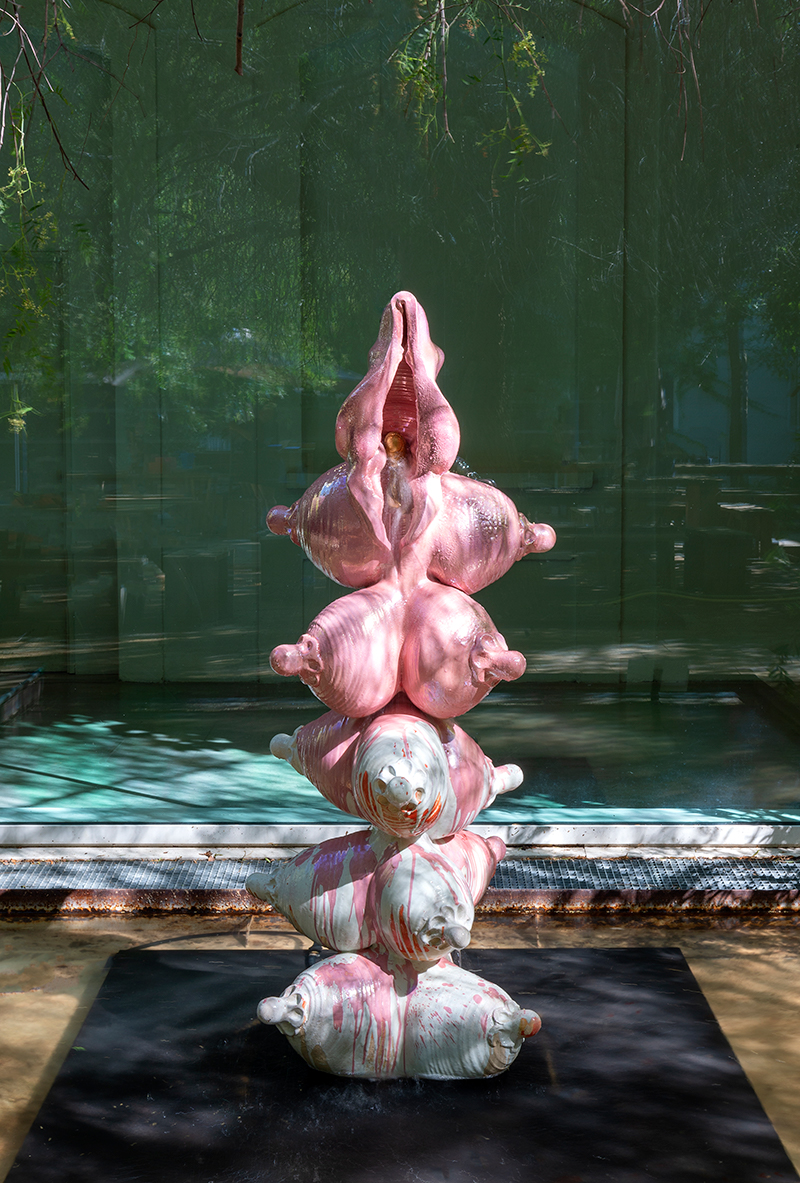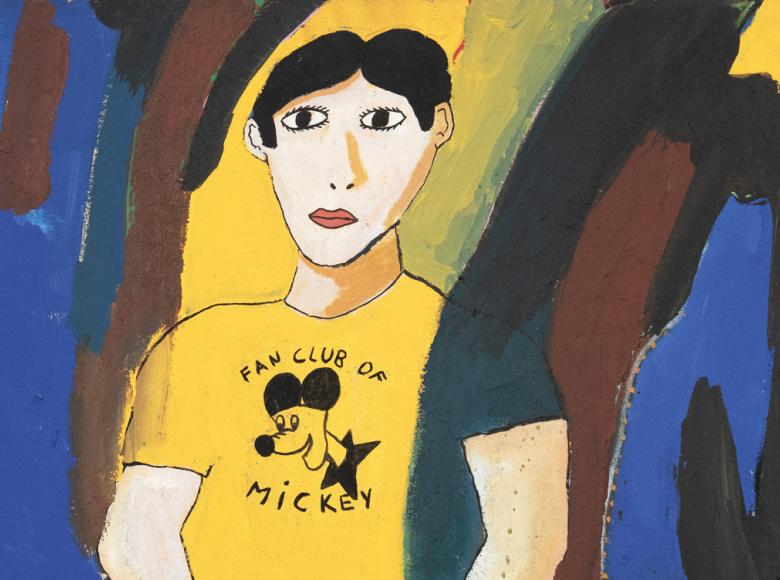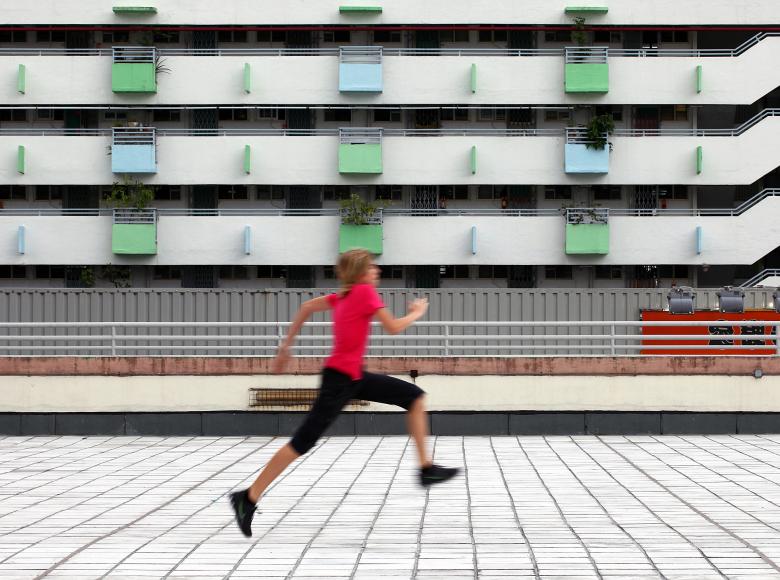A voir en accès libre dans le patio du MO.CO. Panacée
Elsa Sahal
This summer, MO.CO. presents the exceptional work of artist Elsa Sahal in the Panacée patio fountain.
In Elsa Sahal's ceramic fountain, the figure of the Roman goddess of love and feminine beauty, Venus, is associated with knowledge, and therefore polymathy, and with the pleasure of climax. The combination of these attributes, indicated in the title of the enamelled sculpture, evokes different levels of charm. The shapes and colours of this totem also induce seduction. It is covered in a pink, white and glittery dripping glaze, and is made up of numerous generous breasts whose nipples recall multiple eyes, as well as an abundant vulva cradling a golden clitoris. Could we thus consider this sculpture as a magical object, i.e. a protector of individuals belonging to a group? In any case, the sculpture radiates with the energy of empowerment and self-governance through the evocation of the intimate experience of the female body. The fountain is part of a long series of sculptures representing breasts or the figure of Venus itself in the artist's body of work (to name but a few: Venus, 2014, Galerie Papillon, Paris; L'Alanguie, 2019, FIAC, Paris; Venus au mûr, 2020, The Pill, Istanbul; Nichonesque (Titty-esque) 1-4, 2020, The Pill, Istanbul).
Artistic practice
Elsa Sahal sustainably works with blocks of clay, by making use of the permeability, bleakness and transformability of the material. Her ceramic sculptures translate the sensuality of the elements that they are made of: clay, humidity, the imprint of the modelling body, the colours and textures applied to them. They are fired and revived with the use of enamels at the end of the production process.
Her assemblages of fragmentary mono- or polychrome, glossy or matte shapes constitute a joyful grammar by evoking the feeling of the body. Her sculptures act within the field of female corporeality in its most intimate dimensions, with a view to challenging the objectification perpetuated on women's bodies as objects of desire and fertility. It is through irony that Elsa Sahal questions the injunction addressed to women to become and remain available sexual and maternal bodies.
Biography
Born in 1975 in Bagnolet. Lives and works in Paris.
Represented by:
- the Galerie Papillon in Paris (http://galeriepapillonparis.com/?biographie/Sahal&navlang=fr)
- Nathalie Karg Gallery in New York (https://nathaliekarg.com/artists/elsa-sahal/)
- The Pill gallery in Istanbul (http://thepill.co/artists/elsa-sahal/)
- Setareh Gallery in Berlin (https://setareh-gallery.com/artists)
Elsa Sahal is a Paris-based sculptor known for her ceramic works evoking organic forms that disrupt the representation of gender and sexuality through the enigma of morphology. A graduate of the École Nationale des Beaux-Arts (National Institute of Fine Arts) in Paris in 2000, she has been the recipient of numerous awards and residencies, including the Georges Coulon Prize for sculpture, awarded by the Institut de France (2013) and the Manufacture nationale de Sévres (2007-08). She has taught at the ENSAV National School of Architecture in Versailles, the École des arts décoratifs (Institute of Decorative Arts) in Strasbourg and Alfred University New York State College of Ceramic.
Elsa Sahal has also had numerous exhibitions both nationally and internationally, including at the Museum of Art and Design, New York (2013), the National Museum of Women in the arts, Washington DC (2018), the Bonnenfantenmuseum (2016), Maastricht and the Monnaie de Paris (2017). These works are now part of the public collections of the Cnap (2009, 2020), the FMAC (2017) and the Frac Normandie Caen (2021).
The Setareh gallery will present her solo exhibition in Berlin in September 2021, as will the Galerie Papillon in Paris in October 2021. She will also take part in the group exhibition Les Flammes at the Musée d'art moderne in Paris in the autumn.
Words by the artist
“What this sculpture – this endless stream because it is continuous – says, is an ironic way of saying that the women's movement takes time, and that you have to insist, for it is permanent, despite the hostility; you have to keep hoping, precisely, for making sure sustainable equality between men and women sees the light is a long-term struggle, and you have to keep at it.”
Talking about Fontaine (Fountain) (2012) on https://www.franceculture.fr/emissions/linvite-culture/elsa-sahal-sculptrice-du-genre
"I actually work with clay from slabs, I stretch out blocks of clay and build volume around the void. I build a bit like a pattern for a garment, so from plasterboard that I cut out, and assemble. Clay is a very moist material that dries and hardens. There is something organic about it: if the clay is not firm enough, it will sag, you have to find the right timing.
I also like to respond to what the clay offers in terms of folds, sagging or rigidity.
Clay is already a body. There is something very automorphic about this material, something very physical, which induces an iconography, as well as a language that I develop around the body, gender, sexuality, and which nearly forms part of the material.
I started working with ceramics a long time ago, about twenty years now, and I used this material at a time when it was not considered a usable material in the field of contemporary art, which has evolved since then. Things have changed. This material presents huge disparities, from something that is almost despicable, like shit, a very dirty material, all the way to Limoges porcelain. This material can really act on many different levels, it alters a lot, lends itself to the changes of states of matter; in other words, clay is organic, and when it is fired, it becomes mineral. The layer of enamel or the layer of colour acts as an additional skin layer that covers the clay shape. [...]
[…] I think violence must be met with violence. [...]
Clay is a material that can always be reused, that can always be recycled. It is a contemporary material. An essential material because of its permeability, its bleakness, its transformability."
"I adopted clay right away because it is a domestic, non-authoritarian material. I don't like technical virtuosity, the appeal it has, the fascination with mastery, which hinders freedom. The body is inseparable from this material. As if clay already were already the body. […] Clay is the recurring material for my creations in the field of sculpture and installation art. I question this traditional material and infuse it with contemporary energy and concerns. My entire career as an artist has always tended to highlight the contemporary nature of ceramics and place it at the heart of today's art. I try to exploit its possibilities and limits. It is a sensitive material, linked to sensuality, to touch."
Source : http://galeriepapillonparis.com/?biographie/Sahal&navlang=fr
"I don't try to represent the body, it's more about evoking the feeling of the body."
Source : https://www.atelierdesevres.com/actualites/parcours-de-creation-elsa-sahal-sculptrice
Description of the work
Vénus polymathe jouissante (Climaxing polymath Venus), 2019
Enamelled ceramic, hydraulic system
170 x 65 x 65 cm
Vues de l'exposition





